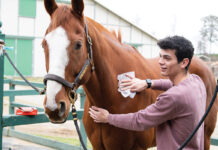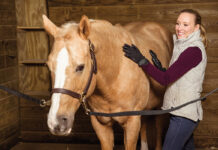 In the good old, bad old days, we used to think tail rubbing was just an annoying habit. Take a look at any horse care book written 30 years ago and you might find the author advising readers to either bandage the tail, set up a tail board in the stall or install a strand of electric wire to zap the horse each time he tried to rub. Nowadays, we know more about autoimmune problems and other health issues, so we understand that blaming the horse isn’t logical. The rule of thumb when dealing with chronic tail rubbing is to try to look for the obvious problems first and then enlist the help of your veterinarian.
In the good old, bad old days, we used to think tail rubbing was just an annoying habit. Take a look at any horse care book written 30 years ago and you might find the author advising readers to either bandage the tail, set up a tail board in the stall or install a strand of electric wire to zap the horse each time he tried to rub. Nowadays, we know more about autoimmune problems and other health issues, so we understand that blaming the horse isn’t logical. The rule of thumb when dealing with chronic tail rubbing is to try to look for the obvious problems first and then enlist the help of your veterinarian.
1. Does your horse have pinworms? The physical symptom of pinworms is tail rubbing. Pinworms crawl out of the anus to lay their eggs. As you can imagine, this causes the horse to rub his tail. Pinworms are unlikely if you’ve been diligent about your deworming. To treat a pinworm infestation, use an equine dewormer labeled for pinworm control. However, consult your veterinarian if you are unsure. Horses heavily infested with parasites should be under a practitioner’s care.
2. Does your horse have dry skin? Susan Harris, Centered Riding Clinician and author of the book Grooming to Win, says to shampoo the tail with a gentle shampoo, then moisturize with a conditioner and finish by rubbing baby oil or Vaseline through the hair and into the skin at the top of the dock. “The hair will be greasy, but this doesn’t matter,” she says. “You’re trying to soothe the skin and stop the itch.” If this doesn’t solve the problem, contact your veterinarian. Your horse could have contact dermatitis caused by something in his environment, such as his bedding.
3. Does your horse have a dirty udder or sheath? If so, tail rubbing is eminent. The cure is to clean the sheath or udder. If you’re unsure, ask a knowledgeable person or your veterinarian for help. (See Sheath Cleaning for more advice.)
4. Does your horse have “sweet itch?” Sweet itch or summer seasonal recurrent dermatitis, is an overreaction to the saliva of a gnat called Colicoides pulicaris. It is thought that sweet itch may be genetic and seems to be most prevalent in ponies. Symptoms include itching, sores, weeping discharge and hair loss. A horse with this affliction will be tormented by itching and will scratch his skin is raw. If you suspect your horse has sweet itch, consult your veterinarian. He or she can show you how to manage this distressing and chronic condition.
That telltale sign of rubbing—ugly splayed tail hairs with a bald patch in the middle – can be disheartening. Remember, your horse doesn’t want to itch. Find the underlying cause of his condition instead of reaching for that tail wrap. Your horse will thank you for it.






I am DEFINATELY going to try everyone of these segestion’s! They shound like it’ll help me greatly to take these steps! I’ll comment again after I’ve tried them all!
What a great place to learn from everyone.
I just have one significant piece of information, the comment about rubbing baby oil on the skin and tail may dry this out even more, being in the field of cosmetology and professional skin care buisness, We were showed in school that baby oil is not a moisturizer.If you were to put this oil in with water it does not dissolve, same if you put it on a cracker, it would still be on the top of cracker 2 days later, this goes for mineral oil as well. Sounds silly, and I am not trying to tell anyone they are wrong for doing this, but not knowing is not knowing. I would of done same until I learned this.
I have learned first hand that baby oil mostly does more bad than good. I would never use it on a horse except for maybe detangling (like a whole wad of burrs in the mane or tail it works good). A product specifically for dry skin on horses is the best option. I like to use mane and tails hoofmaker as I have a mare with dry skin on her tail bone and the crest of her mane in the winter.
My horse Sierra is a thoroughbred and only gets the tail itch in her heat cycle. I found that the best way to manage it is with listerine mouth wash, baby oil and a few drops of lavender only twice a day and rub the sides of her tail area with gold bond skin cream. She is happy and it stops the itching.
Yes, this year our horse is rubbing off her tail hair on top right in the center. Unfortunately, this article really didn’t provide me with any good insights to help the condition. I doubt our horse has pinworms as she is wormed regularly and I don’t see any signs of worms. A neighbor’s horse does have tail rubbing problems worse than our horse but her stable companion, an older mini horse, has no tail rubbing issues at all. The only difference is that the mini horse is a male and my horse and neighbor’s horse are mares. Is this a more common issue in mares? I wish you could give me information to narrow down the tail rubbing cause so treatment might be possible.
Thank you,
Susan
My quarter horse gelding is rubbing his butt on one of my red panel fences. His tail is all red from the fence. But when you move is tail on the sides of his rear is nothing but flesh. Its not bleeding, and we haven’t changed anything that he eats, drinks, etc. We just wormed him twice in a month and half. The fleshy patches aren’t cut up or sliced. It also looks like someone took a razor a shaved the hair off. (HINT: I board my horse at a friends house.)
My vet examined my gelding. No signs of worms. His recommendation was to wash his tail with anti bacterial soup let it dry and then rub in external mild mineral oil. It works for him. I do this once a week and I also use mtg a couple of days before the next wash. Went from bald to braidable within the summer.
we have several horses that present with tail rubbing and they are all a wormer regimen…. geldings and mares.. we tried MTG with no success, baby oil is NOT a moisturizer so I would not use that… last summer I ordered AromaItch and started using it with success. It worked by rubbing it onto the skin of the tail and we also rubbed it on areas on the one horse that actually had hives on his belly and was constantly scratching it as well. This is just what worked for us, not sponsored. Here is the link if anyone is interested
http://www.equinat-usa.com/cgi-bin/shopper.cgi?preadd=action&key=EQUI02
My gelding had this problem of tail rubbing. I was first told it was pin worms and after multiple wormings and negative fecals he still rubbed his tail. I also had a skin scraping done to look for anything like a fungus or mites. I finally decided it must be dry skin. I ended up trying a remedy that also works for llamas with patchy dry skin. It is plain diaper rash cream. I picked up a jar of Desitin cream (Zinc Oxide) and applied it to all of the bare spots around his tail and underneath his tailbone. It worked immediately. So far I have only done one application and his hair is already starting to grow back after 2 weeks! It was a easy and cheap fix after months of struggling to find an answer. I hope it can help any other horses having a tail rubbing problem.
My horse also rubs his upper tail in summer months, as he too has dry skin. I use Udder Cream on top of his tail, under the tail on both sides, and even on his muzzle. It does wonders
I just found that the tail strap of our pony harness has rubbed our pony’s under tail. What can I do to prevent this. The strap is necessary to hold the harness in place correctly and safely.
My horse had a tail itch and he had regular deworming so I did not think it was due to parasites. A friend at my barn recommended the Panacur Power Pack which is a double dose of dewormer daily for 5 days. Heps eliminate gut wall infestationsof strongyles. It worked